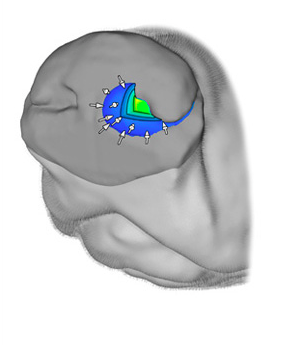How Dogs Scent Directionally
Dogs have an amazing anatomy. Not only do they have structures in their noses that allow them to sample the air at roughly 5 sniffs/second but they also have the ability to house the samples and analyze them without breathing them out. Additionally, they are able to tell which nostril has picked up the odor. That’s right, dogs sniff bidirectionally!
Think about it this way… when you are listening, you can tell if a sound comes from the right or the left. Dogs can do this with their NOSES! It’s utterly fascinating.
The way they can do this is that something called the “aerodynamic reach” of each nostril which is less than the distance between their nostrils. The “reach” of the nostril is based on a spatial area of a small hemispherical inset region of the nostril.

Image attribution: http://www.pbs.org/wgbh/nova/nature/dogs-sense-of-smell.html
Additionally, when the dog exhales, he exhales through the side slits of each nostril. This means that each sample of air does not combine with the exhaled air.
What this means is that dogs are able to tell which direction scent is coming from. This allows them to work a scent cone quickly. Honestly it boggles the mind!
I have seen dogs on the start line zero in on a hide from some distance away. It’s almost as if the canine nose has “depth perception”.
So from a converging odor perspective, this anatomy is the reason why dogs are able to work converging scent cones.
From a cognitive perspective, the olfactory area of the dog’s brain encompasses roughly 12% of the total brain. Like humans, dog’s get more educated over time. By setting out careful puzzles, we can help to support the dog’s overall scent education.
Keep in mind that dogs come to us with a Harvard Education already in sniffing. Through these puzzles that we set, we help them to graduate as rocket scientists.
Think of it this way… when you were younger, spelling was difficult. You knew your letters but may have had to sound out the word. As you learned to read, your brain responsible for language was able to stretch and develop so that you can read much more quickly. Your brain started to learn patterns and it’s these patterns that help us to recognize written language. You can even recognize a word as coming from your own language without even knowing the meaning!
So when we first start working with a Nosework dog, they are learning to spell. They come pre-fitted knowing their alphabet. That part is inborn. With more and more puzzles, their cognition increases and they are able to solve more and more complex problems more and more quickly.
Because of this cognitive development I follow two rules in training:
(1) I let the dog figure out the scent puzzle himself and (2) I don’t try to alter the dog’s “style” of searching.
